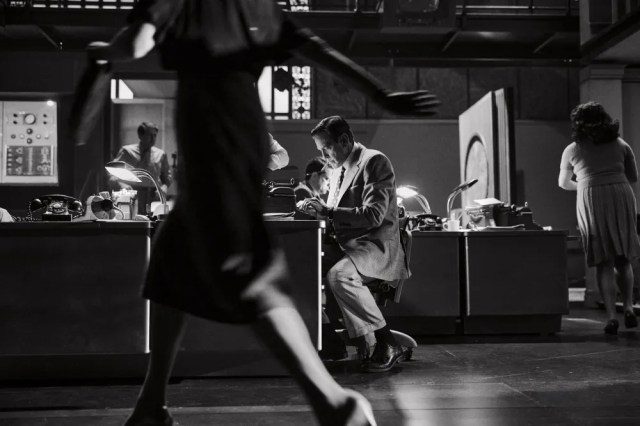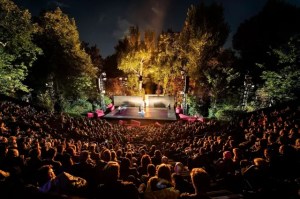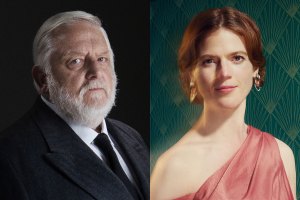George Clooney makes his Broadway debut in Good Night, and Good Luck – read our review
The stage show is based on the film of the same name

(© Emilio Madrid)
As far as history lessons go, there’s no story more urgent than that of news anchor Edward . Murrow taking on Senator Joseph P McCarthy.
George Clooney and Grant Heslov recounted this saga in their 2005 film Good Night, and Good Luck, a George W Bush/Iraq War-era parable about journalistic integrity at a time of great division. It’s no surprise that the pair would choose to revisit the property two decades later, at another time of significant polarisation, when the media distrust is more pervasive than ever. If an op-ed can bring down Joe Biden, maybe a Broadway play can bring down Donald Trump. Lesser artists have tried it and failed; will this one succeed on the strength of its auteurs?
No, probably not. Created with honourable moral intentions, Clooney and Heslov’s dramatic adaptation of Good Night, and Good Luck lands at the Winter Garden Theatre without much urgency. An empty reassembly of their screenplay, with period chicness substituting for tension, the play doesn’t trust the audience to see the parallels between past and present, creating little more than a well-intentioned echo chamber instead of a gripping 90-minutes of theatre.
Clooney and Heslov conjure a bygone era which is expertly translated by the designers. Scott Pask and props supervisors Ray Wetmore and JR Goodman have meticulously rebuilt the CBS broadcast centre at Grand Central Station, with office spaces and bullpens, control rooms and editing bays, and a stunning half-arched window that looms over the action. Brenda Abbandandolo costumes the men in the kind of vintage, to-die-for suits that we wish we could afford, while Heather Gilbert’s hanging halogen lamps provide hot studio lighting.
Taken together, the design immerses us in this grayscale world at the dawn of television, where Murrow decides to take a stand against McCarthy’s communist witch hunt. Clooney, in pinstripes, his hair shoe polish black, is Murrow, the journalist who gained the country’s trust with his wartime radio broadcasts from London. McCarthy, the junior senator from Wisconsin, is played by himself in the same archival clips that Clooney and Heslov used in his movie.
This kind of verité, quasi-documentary style worked on celluloid, where the intentional black-and-white color scheme seamlessly morphed into vintage footage. It’s more indelicate on stage, where director David Cromer forces us to watch them on a giant floating screen that deliberately obscures the action. It’s in these moments that Clooney, delivering the Murrow-penned soliloquies to camera with thrilling conviction, is most alive, and we can barely see it live.

(© Emilio Madrid)
Then again, beyond the production’s gorgeous aesthetic, there isn’t much to see in this tale of how a mighty newsroom, operating without network interference, topples a political gorgon. Clooney and Heslov aren’t playwrights; they’re creatures of the silver screen who haven’t figured out how to translate this important and noble story into a different medium. What can be accomplished instantly through quick cuts and general editing takes forever to achieve here because of the sheer size of the space. Elements that worked in the movie — a jazz singer with a live band whose performances underscore the action — are copied and pasted to less successful effect, basically just padding the length (without them, the running time would be around 80 minutes).
Cromer tries to keep up with the cinematic style, but the result is clumsy. Sections of dialogue are lost without a cinematographer showing who to look at; instead, we just have a gaggle of people talking over each other, stepping on cues. Characters come and go without much differentiation; a crucial subplot involving two secretly married CBS staffers (Carter Hudson and Broad City‘s Ilana Glazer) who endure their own kind of witch hunt barely registers.
Some of the supporting actors rise above. Slings and Arrows star Paul Gross is sturdy as CEO William F Paley, who, if he doesn’t completely support Murrow’s televised condemnation of McCarthy, doesn’t obstruct it. Glenn Fleshler finds some much-needed levity in Clooney’s screen role, Murrow’s producer Fred Friendly. The rest range from pretty good (Clark Gregg as Murrow’s ill-fated protégé Don Hollenbeck) to dismal (Glazer). A collection of fine New York stage regulars — Fran Kranz, Christopher Denham, Will Dagger, Andrew Polk — are caught in the middle, their impact fading in real time like the smoke from their ever-present cigarettes.
The one major change comes at the very end, when Clooney’s delivery of Murrow’s famous “wires and lights in a box” speech is interrupted by a montage (projections by David Bengali) of news footage, culminating in the plane hitting the World Trade Center, the attack on the Capitol, and Elon Musk’s alleged Nazi salute. It’s shocking in the moment (you should hear the gasps), but it’s ultimately distrustful of the audience’s ability to connect the events of the play and the events of today. Everyone who’s in the building understands the contemporary parallels; the people who don’t aren’t coming to see it. We don’t need a clip show to do the work for us, we’re smart enough to consider it ourselves.
I admire that an actor of Clooney’s stature is still willing to push himself in new directions when he has nothing left to prove. He’s telling a significant story that deserves to be heard, especially in an era where the only figures truly challenging the government aren’t journalists at all, they’re comedians and talk show hosts. But Good Night, and Good Luck is a case study in how the best intentions don’t always translate into a compelling theatre experience. As Edward R Murrow himself said, we cannot make good news out of bad practice.















